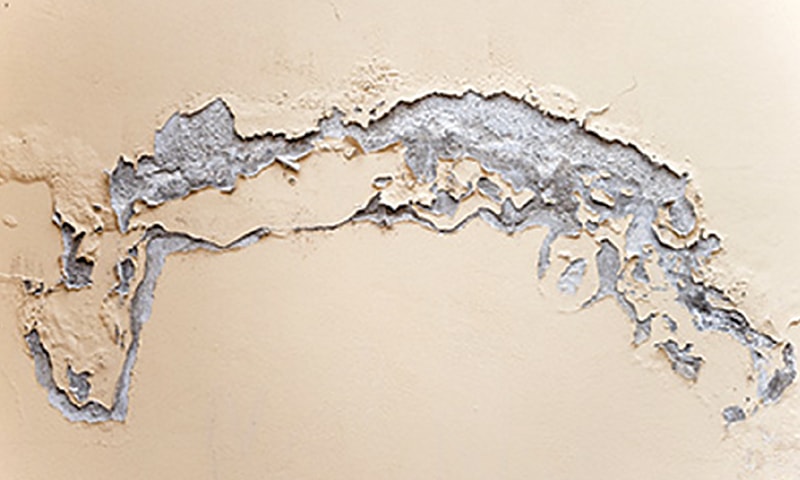Water seepage is every homeowner’s worst nightmare. We’ve all had such experiences at least once in our lives where water has destroyed our floors and walls and we’ve had to hire expensive professional help to fix the seepage. However, at times, you can fix the problem yourself too by simply knowing how to repair or replace the leaking fittings and save some money. But before we go on discussing some easy and inexpensive repairing hacks, let’s first talk about how water diffuses into our homes.
Here are five main ways through which water can seep through our homes:
Through cracks in the floor: There are very small cracks (pores) on the concrete floor. Excess water in the soil under the floor can create pressure, causing water to enlarge the cracks and find its way up through the cracks.
Under the footer: At times a small space is left between the footer (a strip of concrete that supports the structures built on it) and the floor structure during common construction methods. Excess water from under the floor structure finds its way up through this small space and spreads around.
From bleeding and sweating walls: Excess moisture will often cause blocked walls to sweat. The pooled water starts to spread around, moving into the floors even.
Through cracks in walls and joints: If the wall in your living room is leaking, it’s most probably because of the hydrostatic pressure caused by excess moisture in the soil. The walls get blocked over time and when the blockage builds up significantly inside the blocks, water seepage becomes visible. It seeps through cracks causing deposits, mildew as well as water diffusion to the bottom of the wall.
Over the footer: At times, there’s a crack between the footer and the wall sitting on it. Excess water seeps through it, dampening the space around it.
A big question is where does excess water come from? Mostly, excess water is absorbed from defective pipes and faulty pipe joints, but broken sanitary fittings can also cause this leakage. Repairs are usually simple and you can easily do them yourself, however, when occasionally the damage is huge, you may need to engage a plumber.
If you have the knowhow you don’t need to call the plumber for every minor repair

Now since we know where excess water from comes, let’s see how you can repair the leaking pipes yourself; or to say here’s yo4ur doit-yourself guide.
DIY guide to repairing a leaking pipe: The process is a tad technical. First, you need to shut off the main water supply and drain the remaining water in the pipe. Then, use a pipe cutter to cut the damaged area of the pipe, at least one inch from each side of the leak spot. You can start by gripping the pipe tightly with the cutter’s jaw and tightening the cutter’s screw, rotating the jaw firmly till the pipe breaks. Thirdly, dry the pipes and polish the two ends thoroughly. You can then solder a new piece of pipe, if your broken pipe is made of copper.
If not, then you can buy a replacement piece that has a union piece to join the two pipes from any plumbing shop. Tighten the coupling of the two pieces and ensure it is secure and doesn’t leak.
In case you are learning to repair leaking pipes yourself, it is important that you learn to distinguish between different types of pipes used in our homes so you can select the right repairing techniques. Here’s a quick look at the common types of pipes used:
Cast iron: It is durable but can rust over time; therefore it is best to call in professional help to mend the cast iron pipes.
Plastic: These are inexpensive and easy to repair. You can simply glue the joints using a primer and liquid cement.
PVC: This cream coloured pipe is strong, very durable and lasts for a very long time. But these pipes are usually used in drains lines.
Steel: These are very strong pipes and last for over 50 years. It’s best to leave the repair work to a professional for steel pipes.
Copper: These pipes can resist erosion and last longer but are expensive than plastic pipes. Rigid copper is used in home water supply systems while flexible copper is used in appliances like dishwashers, refrigerators, icemakers and others that require water supply. Rigid copper pipes can be cut using a wheel cutter, tube cutter or a hacksaw and are usually connected with soldered (sweat) fittings.
Thus, with some basic understanding of the repair mechanism, you can now mend cracked copper pipes yourself. Give it a shot the next time you have a leakage. If it doesn’t work for you, professional help is just round the corner.
Published in Dawn, Sunday Magazine, November 8th, 2015
On a mobile phone? Get the Dawn Mobile App: Apple Store | Google Play















































Dear visitor, the comments section is undergoing an overhaul and will return soon.